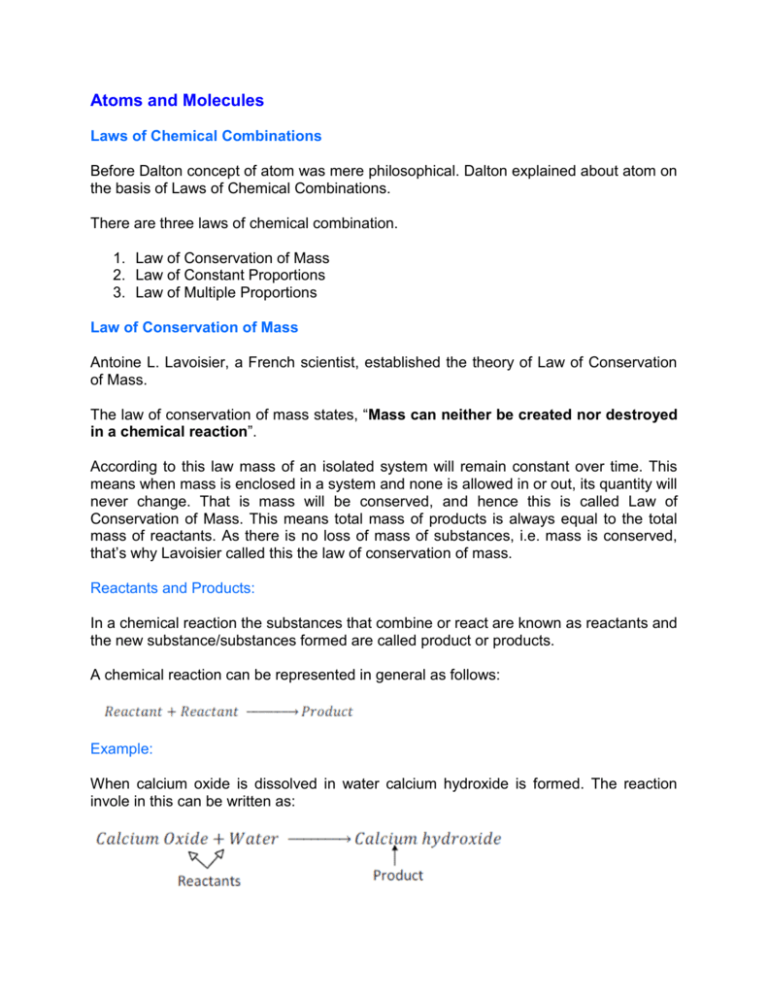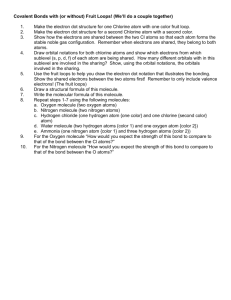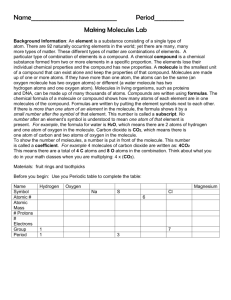Atoms-and-Molecules
advertisement

Atoms and Molecules Laws of Chemical Combinations Before Dalton concept of atom was mere philosophical. Dalton explained about atom on the basis of Laws of Chemical Combinations. There are three laws of chemical combination. 1. Law of Conservation of Mass 2. Law of Constant Proportions 3. Law of Multiple Proportions Law of Conservation of Mass Antoine L. Lavoisier, a French scientist, established the theory of Law of Conservation of Mass. The law of conservation of mass states, “Mass can neither be created nor destroyed in a chemical reaction”. According to this law mass of an isolated system will remain constant over time. This means when mass is enclosed in a system and none is allowed in or out, its quantity will never change. That is mass will be conserved, and hence this is called Law of Conservation of Mass. This means total mass of products is always equal to the total mass of reactants. As there is no loss of mass of substances, i.e. mass is conserved, that’s why Lavoisier called this the law of conservation of mass. Reactants and Products: In a chemical reaction the substances that combine or react are known as reactants and the new substance/substances formed are called product or products. A chemical reaction can be represented in general as follows: Example: When calcium oxide is dissolved in water calcium hydroxide is formed. The reaction invole in this can be written as: In this reaction calcium oxide and water are reactants while calcium hydroxide is product. In this reaction 74 g of calcium hydroxide is obtained when 56 g of calcium oxide reacts with 18 g of water, which is proved by experiment. Here the total mass of reactants, i.e. calcium oxide and water is equal to 74 g. And the mass of product, i.e. calcium hydroxide is also equal to 74g. This proves that the total mass of reactants is always equal to the total mass of product, which proves the Law of Conservation of Mass. Law of Constant Proportions Law of Constant Proportion states that a chemical compound always contains exactly the same proportion of elements by mass. This law is also known as Law of definite proportions. Joseph Louis Proust gave this law hence, this law is also known as Proust’s Law. Explanation of the law:Compounds are formed by the combination of two or more elements. In a compound the ratio of the atoms or element by mass remains always same irrespective of the source of compound. This means a certain compound always formed by the combination of atoms in same ratio by mass. If the ratio of mass of constituent atoms will be altered the new compound is formed. Examples:Water is formed by the combination of hydrogen and oxygen. The ratio of masses of hydrogen and oxygen is always in 1:8 in water irrespective of source of water. Whether you collect the water from a well, river, pond or from anywhere the ratio of their constituent atoms by mass will always same. Nitrogen dioxide is a compound, which is formed by the combination of nitrogen and oxygen. The ratio of nitrogen and oxygen by mass in nitrogen dioxide is in 7:16. Nitrous oxide is a compound which is also formed by the combination of nitrogen and oxygen. The ratio of nitrogen and oxygen in nitrous oxide is in 28:16. Nitric oxide is a compound, which is also formed by the combination of nitrogen and oxygen. The ratio of nitrogen and oxygen in nitric oxide is in 7:8. From the above three examples it is clear that if the ratio of the atoms by mass is altered then the new compound is formed, such as in the case of nitrogen dioxide, nitrous oxide, nitric oxide. These three compounds are formed by the combination of same atoms but because of combination of the constituent atoms in different ratios by mass new compound is formed. Dalton’s Atomic Theory John Dalton, a British Chemists and scientists gave the Atomic Theory in 1808. This theory is popularly known as Dalton’s Atomic Theory in the honour of John Dalton. He gave the theory on the basis of Laws of Chemical Combination and explains them properly. In his theory he explains about atom. Main postulates of Dalton's atomic theory 1. 2. 3. 4. 5. Elements are made of extremely small particles called atoms. Atoms of a given element are identical in size, mass, and other properties; Atoms of different elements differ in size, mass, and other properties. Atoms cannot be subdivided, created, or destroyed. Atoms of different elements combine in simple whole-number ratios to form chemical compounds. 6. In chemical reactions, atoms are combined, separated, or rearranged. Atoms: On the basis of Dalton’s Atomic On the basis of Dalton’s Atomic Theory atom can be defined as the smallest particles of matter are called atoms. Other characteristics of atoms: Atom is the smallest particle of matter. AAll elements are made of tiny particles called atom. Atoms are very small in size and cannot be seen through naked eyes. Atom does not exist in free-state in nature. But atom takes part in a chemical reaction. The properties of a matter depend upon the characteristics of atoms. Atoms are the building block of an element similar to a brick which combine together to make a building. The size of atoms is indicated by its radius. In ancient time atoms was considered indivisible. Symbols of Atoms of Elements For convenience elements are represented by unique symbols. For example: Hydrogen is represented by ‘H’. Oxygen is represented ‘O’. Nitrogen is represented by ‘N’. Iron is represented by ‘Fe’. ments are represented by unique symbols. For example: Hydrogen is represented by ‘H’. Oxygen is represented ‘O’. Nitrogen is represented by ‘N’. Iron is represented by ‘Fe’. His worked proved as boon to science. For his marvelous work Berzilius, together with John Dalton, Antoine Lavoisier, and Robert Boyle is considered as the Father of Modern Chemistry. Symbol of many elements are taken from their English name, while symbol of many elements are taken from their Greek or Latin names. Symbol of some element which are derived from their Latin name Several elements are named after the place where they discovered, such as ‘Copper’ which was taken from Cyprus. Some elements are named after their colour, such as ‘Gold’ which means yellow. Atomic Mass Mass of atom is called atomic mass. Since, atoms are very small consequently actual mass of an atom is very small. For example the actual mass of one atom of hydrogen is equal to 1.673 x 10-24 g. This is equal to 0.000000000000000000000001673 gram. To deal with such small nuber is very difficult. Thus for convenience relative atomic mass is used. Carbon-12 is considered as unit to calculate atomic mass. Carbon-12 is an isotope of carbon. The relative mass of all atoms are found with respect to C12. One atomic mass = 1/12 of the mass of one atom of C-12. Thus atomic mass is the relative atomic mass of an atom with respect to 1/12th of the mass of carbon-12 atom. ‘amu’ is the abbreviation of Atomic mass unit, but now it is denoted just by ‘u’. The atomic mass of hydrogen atom = 1u. This means one hydrogen atom is 1 times heavier than 1/12 th of the carbon atom. The atomic mass of oxygen is 16u, this means one atom of oxygen is 16 times heavier than 1/12th of carbon atom. Absolute mass or Actual atomic mass: It is found that, the actual atomic mass of a carbon-12 atom is equal to 1.9926 X 10-23g. Thus by multiplying the relative atomic mass with 1.6605 × 10 -24 g we can get the absolute or actual mass of an atom. Example -1 - Find the absolute mass oxygen. Example – 2 – Find the absolute mass of Sodium. Example – 3 – Calculate the absolute mass of hydrogen atom. Example – 4 - Calculate the absolute or actual mass of Nitrogen atom. Existence of Atoms Atoms of most of the elements exist in the form of molecule or ion, since they are most reactive. For example, hydrogen, oxygen, chlorine, etc. However, atoms of some elements, which are non-reactive, exist in free-state in nature. For example helium, neon, argon, etc. Usually atoms are exist in following two forms • In the form of molecules • In the form of ions Molecule:Molecule is the smallest particle of a compound. Atoms exist in free states in the form of molecule. A molecule may be formed by the combination of two or more similar atoms of an element, such asoxygen molecule is formed by the combination of two oxygen atoms, molecule of hydrogen which is formed by the combination of two hydrogen atoms. Molecules may be formed by the combination of atoms of two or more different elements. For example molecule of water. It is formed by the combination of two atoms of hydrogen and one atom of oxygen. Molecule of Nitric oxide or nitrogen monoxide. It is formed by the combination of one nitrogen atom and one oxygen atom. A molecule tA molecule takes part in chemical reaction. Most of the atoms exist in the form of molecule. Molecules are formed by the combination of two or more elements. Example: Molecule of hydrogen (H2), Molecule of oxygen (O2), Molecule of nitrogen (N2), etc. • Molecules of elements • Molecules of Compounds Molecules of elements: When two of more atoms of same element combine to form a molecule these are called molecules of element. Example: Hydrogen molecule (H2). Hydrogen molecule (H2). Molecule of hydrogen is formed by the combination of two hydrogen atoms. Oxygen molecule (O2). Molecule of oxygen is formed by the combination of two oxygen atoms. Sulphur molecule (S8). Molecule of sulphur is formed by the combination of eight sulphur atoms. Phosphoroud molecule (P4). Molecule of phosphorous is formed by the combination of four phosphorous atoms. Molecules of some non-reactive elements are formed by single atom. For example – helium, neon, argon, etc. molecules: Molecules of metals formed as big cluster of atoms. They are represented by their symbols simply. For example: Iron (Fe), Copper (Cu), Zinc (Zn), etc. These molecules are known as giant molecules. Carbon is a non-metal, but it also exists as giant molecule and represented by its symbol ‘C’. Atomicity Monoatomic: When molecule is formed by single atom only, it is called monoatomic molecule. Generally noble gas forms monoatomic molecules. For example: Helium (He), Neon (Ne), Argon (Ar), Kr (Krypton), Xenon (Xe), Randon (Rn). Diatomic: When molecule is formed by the cDiatomic: When molecule is formed by the combination of two atoms of it is called diatomic molecule. For example: Hydrogen (H2), Oxygen (O2), Nitrogen (N2), Chlorine (Cl2), etc. Triatomic: When moleucule is formed by the combination of three atoms it is called triatomic molecule. For example: molecule of ozone (O3) Tetra-atomic:- When molecule is formed by the combination of four atoms it is called tetra-atomic molecule. For example: Phosphorous molecule (P4) Polyatomic:- When molecule is formed by the combination of more than two atoms, it is called polyatomic molecule. For example: Sulphur molecule (S8) Molecules of compounds: When molecule is formed by the combination of two or more atoms of different elements, it is called the molecule of compound. Example:Molecule of water (H2O). Molecule of water is formed by the combination of two hydrogen and one oxygen atoms. Ions: Atoms of several elements exists in the form of ion. Atoms or molecule with negative or positive charge over them are called ions. Cations: Ions having positive charge over them are called cations. Anions: Ions having negative charge over them are called anions. Monoatomic ions: Ions formed by one atom are called monoatomic ions. Polyatomic ions: Ions formed by two or more atoms are called polyatomic ions.








